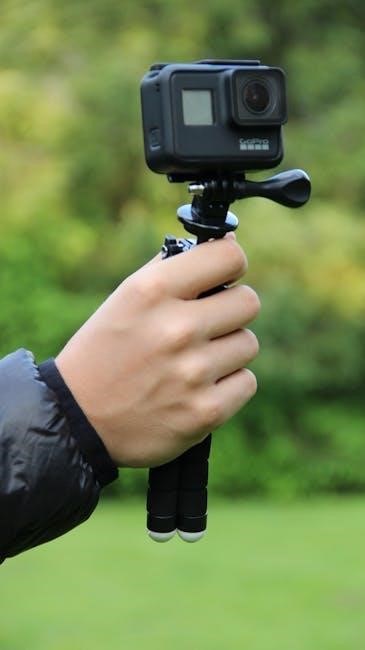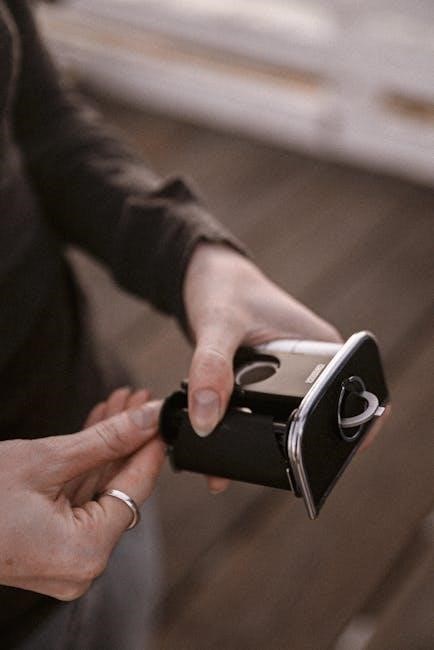Safety Precautions and Preparation
Always supervise children near the unit and ensure it is installed on a stable surface. Avoid tilting or moving the air conditioner while in use. Read the manual carefully before operation to ensure proper setup and safety. Keep the unit away from flammable materials and follow all electrical safety guidelines to prevent hazards.
1.1 Essential Safety Notices
Always supervise children when the air conditioner is in operation. Do not allow children to play with the unit or its controls. Immediately turn off and unplug the unit if it tips over or shows signs of damage. Never operate the air conditioner near water or in areas where it may come into contact with flammable materials. Regularly inspect the power cord and plug for damage or wear.
1.2 Pre-Installation Checks
Ensure the area is clear and well-ventilated before setting up the air conditioner. Check for any damage to the unit, hoses, or power cord. Verify all components are included in the package. Measure the space to ensure proper fit and airflow. Prepare necessary tools, such as a Phillips screwdriver and tape measure. Ensure the surface is level and stable to prevent tipping. Inspect the venting area for obstructions before installation.

Operating Instructions
Set the desired temperature using the remote or control panel. Choose cooling, fan, or dehumidify mode based on your needs. Use the swing function for even air distribution. Monitor the LED display for status updates. Adjust settings via the Toshiba Smart AC app for convenience. Always keep the unit supervised during operation and ensure it is placed on a stable, level surface.
2.1 Basic Operations and Controls
Press the power button to turn the unit on or off. Use the remote or control panel to adjust temperature, fan speed, and modes (Cool, Fan, Dry). The LED display shows current settings. Select the swing function for air direction control. Choose from low, medium, or high fan speeds. Ensure the unit is placed on a firm, level surface for proper operation. Always refer to the manual for optimal performance and safety.
2.2 Advanced Features and Settings
Enable advanced modes like Energy-Saving and Silent Operation for optimized performance. Use the programmable timer to schedule cooling sessions. The Toshiba Smart AC app offers remote control via Wi-Fi, allowing temperature adjustments and mode changes from your smartphone. Access additional settings through the app, such as eco-friendly options and custom fan speeds. Refer to the manual for detailed setup instructions and troubleshooting tips.
Installation and Venting
Ensure proper venting by using the provided hose and window kit. Secure the vent to prevent air leaks and maintain efficiency. Follow manual guidelines for optimal setup and safety;
3.1 Tools and Materials Needed
To install your Toshiba portable air conditioner, you’ll need a Phillips screwdriver, a tape measure, and the included venting kit. Ensure all parts are accounted for before starting. The venting hose and window adapter are essential for proper installation. Refer to the manual for specific tools and materials to avoid missing any components. Proper preparation ensures a smooth setup process.
3.2 Step-by-Step Venting Setup
Attach the venting hose to the air conditioner’s exhaust port, securing it with the provided clamp. Place the window adapter in the window frame, ensuring a tight seal. Extend the hose to the adapter, keeping it straight to avoid kinks. Close the window to secure the adapter and ensure proper ventilation. Turn on the unit to test airflow. Proper venting is essential for efficient cooling and safe operation.

Maintenance and Cleaning
Regularly clean the air filter to ensure optimal performance. Check for blockages in the venting system and drain condensation properly. Store the unit in a dry, cool place during off-season to maintain efficiency and longevity.
4.1 Cleaning the Air Filter
Turn off and unplug the unit before cleaning. Remove the air filter and vacuum dust or wash it with mild detergent. Allow it to dry completely before reinstalling. Regular cleaning improves airflow and efficiency. Replace the filter if damaged. Proper maintenance ensures optimal performance and prevents dust buildup, which can reduce cooling effectiveness. Always follow the manual’s guidelines for filter care.
4.2 Draining Condensation and Storage
To drain condensation, turn off and unplug the unit. Tilt it carefully or use the built-in drainage system with a hose. Ensure the reservoir is empty before storing. Clean the unit thoroughly, removing any moisture. Store it in a dry, cool place to prevent mold. Check for blockages in the drainage system to ensure proper function. Proper storage maintains efficiency and longevity of the air conditioner.
Troubleshooting Common Issues
Check for power issues, clogged filters, or blocked vents if the unit isn’t cooling. Ensure proper drainage to avoid water leakage. Refer to the manual for specific solutions to address common operational problems effectively.
5.1 Diagnosing No Cooling or Low Performance
If your Toshiba portable air conditioner isn’t cooling properly, first check the air filter for cleanliness and ensure it’s free from blockages. Verify that the thermostat is set correctly and the unit is properly sized for the room. Inspect the exhaust hose for kinks or damage, as restricted airflow can reduce performance. Also, ensure the condenser coils are clean and unobstructed for optimal efficiency.
5.2 Solving Drainage and Water Leakage Problems
If water leakage occurs, ensure the drainage port is unobstructed and properly connected. Regularly empty the water tank and check for blockages in the drain hose. Tilt the unit slightly to drain excess water. For persistent issues, inspect the internal components for damage or misalignment. Refer to the manual for specific drainage setup instructions to prevent water accumulation and leakage problems.

Remote Control and Smart App Instructions
Scan the QR code in the manual to download the Toshiba NA AC app. Pair the remote by holding the VENT ANGLE/SWING button for 3-5 seconds during setup.
6.1 Pairing the Remote with the Unit
To pair the remote with your Toshiba portable air conditioner, press and hold the VENT ANGLE/SWING button for 3-5 seconds. The unit will enter Access Point mode, indicated by a display change. Ensure the remote is within range and follow on-screen instructions to complete pairing. This ensures seamless control over cooling, fan speed, and dehumidifier functions. Proper pairing is essential for optimal performance and convenience.
6.2 Connecting to the Toshiba Smart AC App
Download the Toshiba Smart AC app from Google Play or the App Store. Scan the QR code on your air conditioner to begin setup. Open the app, select your device, and follow in-app instructions. If prompted, press and hold the Connect button on the unit for 3-5 seconds to enter Access Point mode. The display will show AP when connected. This allows remote control and scheduling for enhanced convenience.

Eco-Friendly and Energy-Saving Features
Toshiba portable air conditioners feature energy-efficient modes that reduce power consumption while maintaining optimal cooling performance. Designed to comply with environmental standards, they offer eco-friendly operation and energy savings.
7.1 Energy Efficiency Modes
Toshiba portable air conditioners offer advanced energy-saving modes to optimize cooling while reducing power consumption. Features like Eco Mode and smart sensors adjust operation based on room conditions, ensuring efficient energy use. These modes help lower utility bills and promote environmentally friendly operation without compromising comfort. The units are designed to meet high energy efficiency standards, making them a sustainable choice for cooling needs.
7.2 Environmental Benefits and Compliance
Toshiba portable air conditioners are designed to minimize environmental impact. They use eco-friendly refrigerants and comply with global energy efficiency standards. The units are built with recyclable materials, reducing waste. By meeting strict environmental regulations, these air conditioners promote sustainable cooling solutions. Their energy-efficient design helps lower carbon footprint, making them a responsible choice for eco-conscious users seeking reliable and environmentally friendly cooling options.
User Reviews and Feedback
Users praise Toshiba portable air conditioners for their efficiency and eco-friendly design. Many appreciate the ease of use and smart app connectivity. However, some note occasional drainage issues affecting performance.
8.1 Common Praises and Positive Experiences
Users often highlight the Toshiba portable air conditioner’s efficient cooling performance and ease of setup. Many appreciate its compact design and quiet operation, making it ideal for small spaces. The smart app connectivity and remote control features are frequently praised for convenience. Several customers also commend the eco-friendly modes and energy-saving capabilities, which help reduce utility bills. Overall, the unit is well-regarded for its reliability and user-friendly interface.
8.2 Reported Drawbacks and Improvements
Some users report issues with condensation drainage and water leakage, suggesting better drainage solutions. Others mention difficulty with smart app connectivity and venting setup. A few note that the unit’s cooling performance is less efficient in larger spaces. Improvements could include a more intuitive app interface and clearer instructions for optimal venting and drainage to enhance user experience and functionality.
Regular maintenance and proper installation ensure optimal performance. Follow the manual for troubleshooting and settings. Enjoy efficient cooling and energy savings with Toshiba’s portable AC.
9.1 Summary of Key Features
The Toshiba portable air conditioner offers 10,000 BTU cooling capacity, covering up to 350 sq. ft. It features a dehumidifier function, smart app control via Wi-Fi, and a remote control for convenience. Energy-saving modes optimize performance, while the compact design includes caster wheels for easy mobility. The unit also supports auto-restart after power outages, ensuring uninterrupted operation. These features make it a versatile and efficient cooling solution for various spaces.
9.2 Best Practices for Long-Term Use
Regularly clean the air filter to maintain efficiency and airflow. Ensure proper installation and venting to avoid performance issues. Drain condensation regularly to prevent water accumulation. Check for blockages in the vent hose and keep the unit on a level surface. Use the Toshiba Smart AC app to monitor and adjust settings for optimal performance. Store the unit dry during off-seasons to extend its lifespan and maintain energy efficiency.
